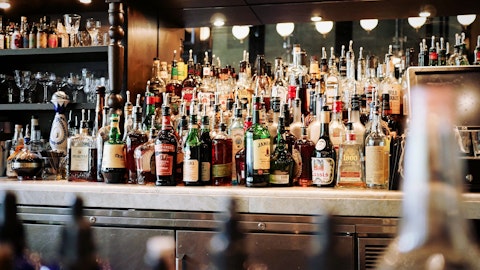Eastside Distilling, Inc. (NASDAQ:EAST) Q3 2023 Earnings Call Transcript November 18, 2023
Operator: Good afternoon, and welcome to the Eastside Distilling Third Quarter 2023 Financial Results Conference Call. All participants will be in listen-only mode. [Operator Instructions] After today’s presentation there will be an opportunity to ask question. [Operator Instructions] Please note, this event is being recorded. I would now like to turn the conference over to Tiffany Milton, Controller. Please go ahead.
Tiffany Milton: Thank you. Good afternoon, everyone, and thank you for joining us today to discuss Eastside Distilling’s financial results for the third quarter of 2023. I’m Tiffany Milton, Eastside’s Controller. And joining us on today’s call to discuss these results are Geoffrey Gwin, the company’s Chief Executive Officer; and Bruce Wells, Craft Controller. Following our remarks, we will open the call to your questions. Now before we begin with prepared remarks, we submit for the record the following statement. Certain matters discussed on this conference call by the management of Eastside Distilling may be forward-looking statements within the meaning of Section 27A of the Securities Act of 1933, as amended, and Section 21E of the Securities Exchange Act of 1934, as amended, and such forward-looking statements are made pursuant to the safe harbor provision of the Private Securities Litigation Reform Act of 1995.

A closeup shot of a beer tap pouring a golden lager.
The forward-looking statements describe future expectations, plans, results or strategies and are generally preceded by words such as may, future, plan or planned, will or should, expected, anticipates, draft, eventually or projected. Listeners are cautioned that such statements are subject to a multitude of risks and uncertainties that could cause future circumstances, events or results to differ materially from those projected in the forward-looking statements. Such matters involve risks and uncertainties that may cause actual results to differ materially include, but are not limited to, the company’s acceptance and the company’s products in the market, success in obtaining new customers, success in product development, ability to execute the business model and strategic plans, success in integrating acquired entities and assets, ability to obtain capital, ability to continue its going concern and all the risks and related information described from time to time in the company’s filings with the Securities and Exchange Commission, including the financial statements and related information pertaining to the company’s annual report on Form 10-K for the year ended December 31, 2022, filed with the Securities and Exchange Commission.
Now with that said, I’d like to turn the call over to Geoffrey Gwin. Geoffrey, please proceed.
Geoffrey Gwin: Thank you, Tiffany, and welcome, everyone, to the third quarter earnings conference call. I appreciate the opportunity to discuss our performance and outlook with you. While we’ve made strides towards our goal of achieving positive operating cash flow, both in the Craft digital canning business and our spirits business, there are challenges we need to address. All year long, I have spoken about the collective goals I have laid out for both craft and spirits segments to generate EBITDA and, importantly, net income that not only allows us to invest in growth but also to deleverage and to offset the public company costs. And while we’ve made progress towards these goals, it’s clear that we still have work to do. One significant challenge we’re facing is the growing economic headwinds in both the craft beverage and spirits categories.
Unfortunately, these headwinds have intensified towards the end of the third quarter and into the fall. The external economic environment plays a crucial role in our ability to achieve our financial objectives. Understanding and navigating these challenges will be key to reaching our targets. Now in the Craft digital printing segment, the quarter showcased positive developments with notable wins in our new digital printing customers, such as [ Ford Percy ] in the water category who, by the way, is at the forefront of using digital printing to market to consumers. Craft’s record-breaking quarter with 4.8 million digital can orders demonstrates continued demand for our services. While we faced challenges in the mobile canning business, improvements in scrap and utilization offset some of these issues.
As we approach the fourth quarter, we anticipate seasonal softness, a trend observed in the same period last year. Now moving on to spirits. We experienced a notable improvement with spirits EBITDA loss of only $70,000 in the quarter, a significant reduction compared to the previous year. Despite an overall decline in the top line, Portland Potato Vodka performed well, and we observed softness in various spirit categories, including tequila category, which has historically been a very strong performer. Despite these challenges, we managed to mitigate the impact by implementing successful pricing strategies in key markets. While Burnside and Azunia require more attention to the underinvestment, our strategic focus on winning territories, rightsizing production and improving the supply chain is yielding positive results, as reflected in improved EBITDA performance.
Corporate and G&A expenses remain a challenge for our company our size, but we’ve made progress in reducing costs. And Tiffany will provide some details on the onetime loss associated with the completed debt for equity swap. So if you exclude those losses, our adjusted EBITDA shows meaningful progress in the quarter. As we end the fourth quarter, we acknowledge the need for further improvements across all assets of the business to achieve positive cash flow and net income. Our ongoing efforts to address challenges enhance operational efficiency and capitalize on opportunities that position us for success. We remain committed to our goals and are optimistic about the future. Now I’ll turn it over to Tiffany to provide additional insights into our financials and the completed debt for equity swap.
Tiffany, please go ahead.
Tiffany Milton: Thank you, Geoffrey, and thank you all again for joining our call today. Let’s review the third quarter. On a consolidated basis, our gross sales were $3.1 million for both the third quarter of 2023 and 2022, primarily due to growth in digital can printing offset by lower mobile canning and spirits sales. Craft sales were $2.2 million for 2023 and $1.9 million for 2022 as we continue to improve our printed can production. Spirits sales were $850,000 for 2023 compared to $1.2 million for 2022, primarily due to bulk spirits sales of $244,000 in Q3 of 2022. Our consolidated gross profit was $500,000 for Q3 2023 compared to $200,000 for Q3 of 2022 due to Craft improvement from digital can printing. Our consolidated gross margins were 17% for 2023 and 6% for 2022.
Craft had margins of 16% for 2023 and negative 7% for 2022. Spirits margins were 21% for 2023 and 29% for 2022. Excluding barrel sales, spirits margins were 27% for both 2023 and 2022. Adjusted EBITDA was negative $430,000 for 2023 and negative $1.4 million for 2022, primarily due to decreased operating expenses. During Q3 2023, we recorded a loss on the conversion of debt to equity of $1.3 million, which is excluded from adjusted EBITDA. Craft printing operations have yet to reach a turning point, demonstrating its full potential and delivering positive EBITDA in the quarter. However, we continue to gain momentum in the printing sector and are exploring avenues to streamline operating costs. These cost-cutting measures are set to be expanded throughout the remainder of the year.
We will now open the floor for questions. Operator?
See also 15 Largest Wool Producing Countries in the World and 10 Best Selling Smartphones in the World in 2023.
Q&A Session
Follow Eastside Distilling Inc. (NASDAQ:EAST)
Follow Eastside Distilling Inc. (NASDAQ:EAST)
Operator: [Operator Instructions] The first question is from Matthew Campbell of Laridae Capital. Please go ahead.
Matthew Campbell: Hi. Good afternoon, Geoff. I continue to see some improvement here, a continued improvement on the cost side. I was wondering if you could talk about mobile canning business being down relative to maybe what the forecast was and, at the same time, Craft digital growing and how you think about that business on a going-forward basis in terms of better visibility.
Geoffrey Gwin: Right. Thanks for the question. Mobile is not an easy business. I mean if you think about it, it’s a logistics business. You’re moving basically a canning line remotely to the customer. You’re setting it up. If your customer is struggling with their product, the temperature is not right, carbonation is not right, it’s your problem and you’re trying to figure out how to basically can it, deliver a great product and then you pack it all off and go home. And you’re paying for this the whole time. And so a critical part of that story is utilization — concentration, utilization, not driving 6 hours, spending a lot of time on that. And that’s something that Craft did well for a long time. We were in Denver, Seattle, Portland, so can is dominant in the Pacific Northwest.
And that’s not a business that we want to invest the time on, frankly. That’s a business that we want to develop, improve, but we want to be in the digital canning printing business. I mean, we know for a fact, large consumer product companies, Coca-Cola, Budweiser, the PGA, have turned to digital printers to digitally print special-edition cans for various things that they’re doing, not with us but hopefully with us at some point in the near term. That’s the business that we want to invest in. So we’re going to spend less time on mobile. But having said that, mobile is critical right now because, last year, we converted almost all our mobile customers to digital print customers, right? They were important for the build-out of the demand curve for us.
So we’re going to stay involved in Portland digital, mobile canning, and we’re going to serve our customers there, but we’re going to focus on printing.
Matthew Campbell: Got it. So when you look at that business, how much of the mobile business was like affected?
Geoffrey Gwin: It’s largely Seattle. We initially expected to invest in Seattle, capture more market share, compete on price there, and we decided that we’re just going to defend and compete in Portland very vigorously. We’re not going to give up any share there, and that’s where we’ll be. And so initially, when we looked at the year, and I was looking at the opportunity for the company, I was expecting for the third quarter that mobile would be stronger in Seattle. And our sense is that we would be able to convert more of the demand that we are building on in the early part of the year in the third quarter in digital printing. I think we got distracted at Craft, focusing on mobile, restructuring it, exiting Seattle. And that’s one reason why we weren’t able to generate the EBITDA in the quarter that I thought we were going to do for that segment.
Matthew Campbell: Got it. That’s helpful. And just a little bit more color around Portland Potato Vodka. It sounds like that’s starting to bounce back for you. Why is that occurring? And then just a little color on why we’re seeing that.
Geoffrey Gwin: So let’s talk about the three major brands, and we have a lot of brands, but our three major brands are Portland Potato Vodka and Burnside, those are focused in Portland and Pacific Northwest; and then we have Azuñia, the tequila brand that we purchased a few years ago. Vodka for us is a critical space because that’s a place where we can do a lot of volume, and we can do a lot of volume with our concentrated footprint in Portland. We can really deliver more cases, more volume, leverage the fixed expense base. What you’ve seen with this company is we’ve been shifting investment from spirit brands to the digital can printing. And a lot of people ask me, why are you doing that? Spirits is supposed to be a hot category.
And the truth of the matter is it is a hot category, but it’s extremely difficult to do, to compete, in California with the 3-tier distribution system and the way that the structure of the segment operates. You’re going to need a tremendous amount of capital or you’re going to need a celebrity partner or someone who can pull demand through a reluctant distributor. That’s a fact. I mean that’s a real challenge. However, thankfully, we have a strong market position in a control state in Oregon, and that limits the leverage the distributor has on taking gross margin from us. So I’m growing the spirits business back in Oregon first. And then we will expand when we have more leverage with our partners, right? So Portland Potato Vodka is critical.



